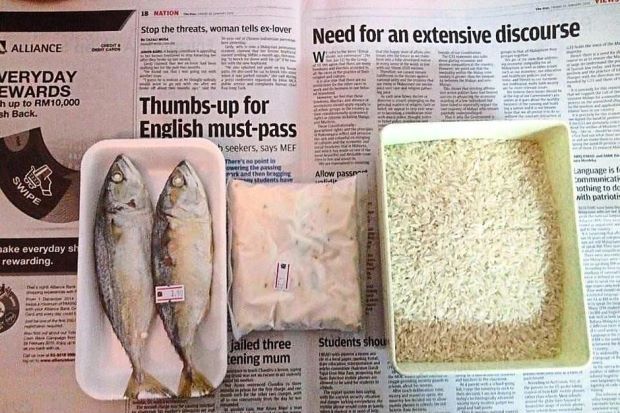How much food can we get with 7 ringgit ($1.94)?
Stefen Chow, a Beijing-based Malaysian photographer, is calling on the public to join in “The Poverty Line” project by submitting photographs of food items bought with 7 ringgit on a sheet of newspaper.
Stefen Chow, a Beijing-based Malaysian photographer, is calling on the public to join in “The Poverty Line” project by submitting photographs of food items bought with 7 ringgit on a sheet of newspaper.

“It is how much a person living on the poverty line can afford to spend on food each day,” said Chow, 35.
Among the entries he has received so far include a packet of nasi kandar submitted by Belinda Ho in Penang; and a selection of grocery items such as potatoes, tomatoes, eggs, shallots, ladies’ fingers and curry powder by Joseph Foo in Kuala Lumpur.
“The Poverty Line” (www.thepovertyline.net/) is a visual project created by Chow and his wife Lin Hui-Yi back in 2010 in Beijing, and since then, it has been expanded to more than 20 countries.
Viewers are able to discern the countries discussed based on the newspapers that serve as the background, while the newspaper’s content conveys social context at the time the photographs were taken.
Chow’s job as a freelance photographer allows him to travel around the world.
Lin, an economist, works out the amount of money a poor person allocates for food per day in each country, while Chow then purchases food items from local grocers and photographs them on local newspapers.
Essentially, the project attempts to answer the question “What does it mean to be poor?”
Beginning early this month, Chow and Lin decided to open up for submissions from people residing in Malaysia, Singapore (S$2.25 or $1.68), India (47 rupees or $0.76) and Hong Kong (HK$25.25 or $3.26).
By responding to their call, the public becomes part of the larger discussion about poverty and food choices around the world.
“While artwork is, a lot of times, a one-way conversation with the artists communicating their intentions for interpretation, we are inviting the public to be part of the conversation in this case.
“We have already thought about it for years to engage the audience in a two-way conversation with the artwork,” Chow said when contacted.
Chow, whose photograph of Chinese dissident artist Ai Weiwei won the second prize in the staged portraits category in the 56th World Press Photo contest in 2013, lives in Beijing with Lin and their daughter.
“The Poverty Line” was also awarded the grand prize in Arles Open Photography Salon in 2011.
“We intend to open this project to 60 countries by the end of the year and hopefully it will morph into an international movement,” he said.
By Tho Xin Yi
(The Star)
-
Articles by Korea Herald








![[Kim Seong-kon] Democracy and the future of South Korea](http://res.heraldm.com/phpwas/restmb_idxmake.php?idx=644&simg=/content/image/2024/04/16/20240416050802_0.jpg&u=)








![[KH Explains] Hyundai's full hybrid edge to pay off amid slow transition to pure EVs](http://res.heraldm.com/phpwas/restmb_idxmake.php?idx=652&simg=/content/image/2024/04/18/20240418050645_0.jpg&u=20240418181020)

![[Today’s K-pop] Zico drops snippet of collaboration with Jennie](http://res.heraldm.com/phpwas/restmb_idxmake.php?idx=642&simg=/content/image/2024/04/18/20240418050702_0.jpg&u=)